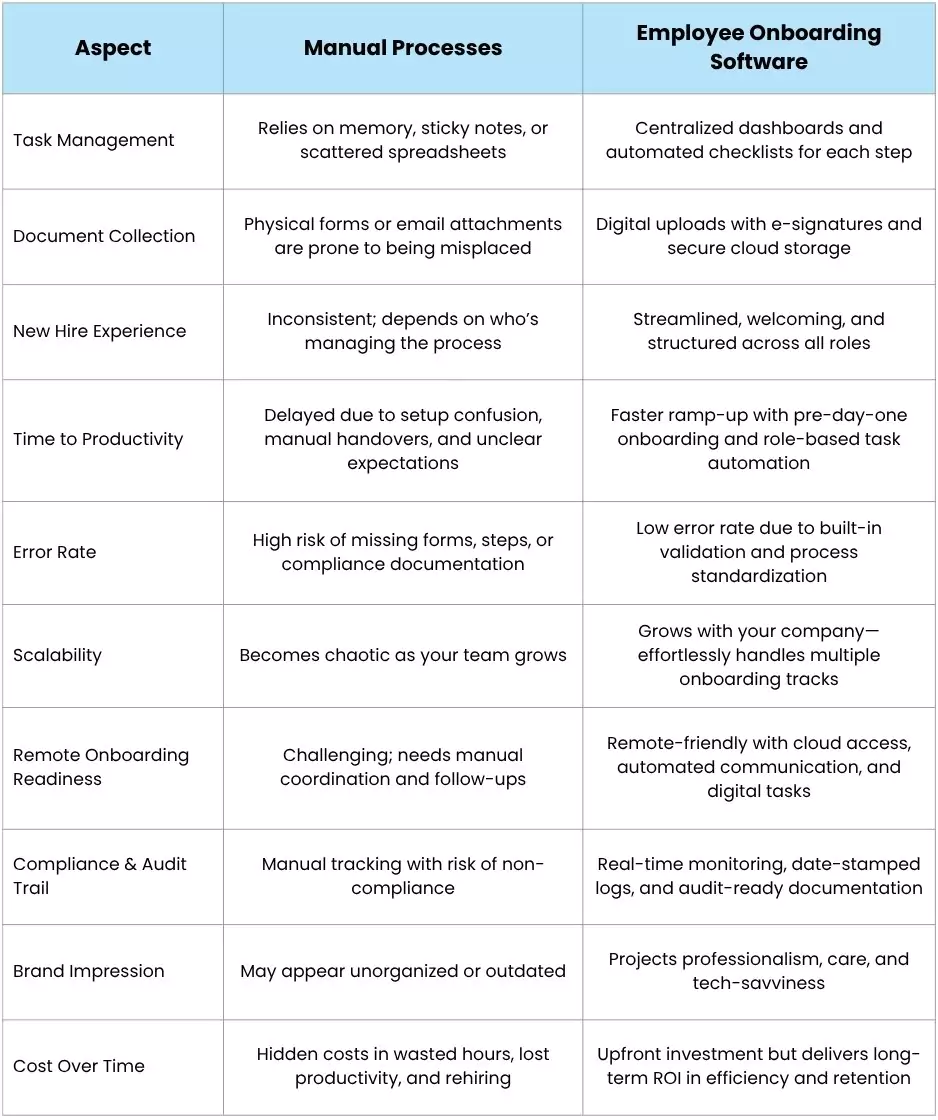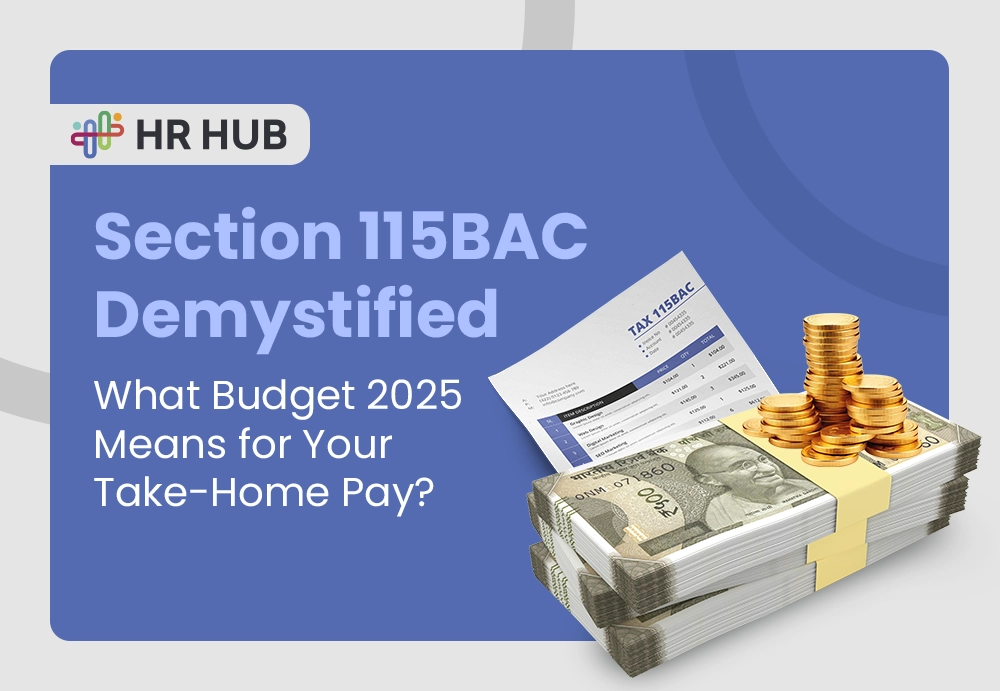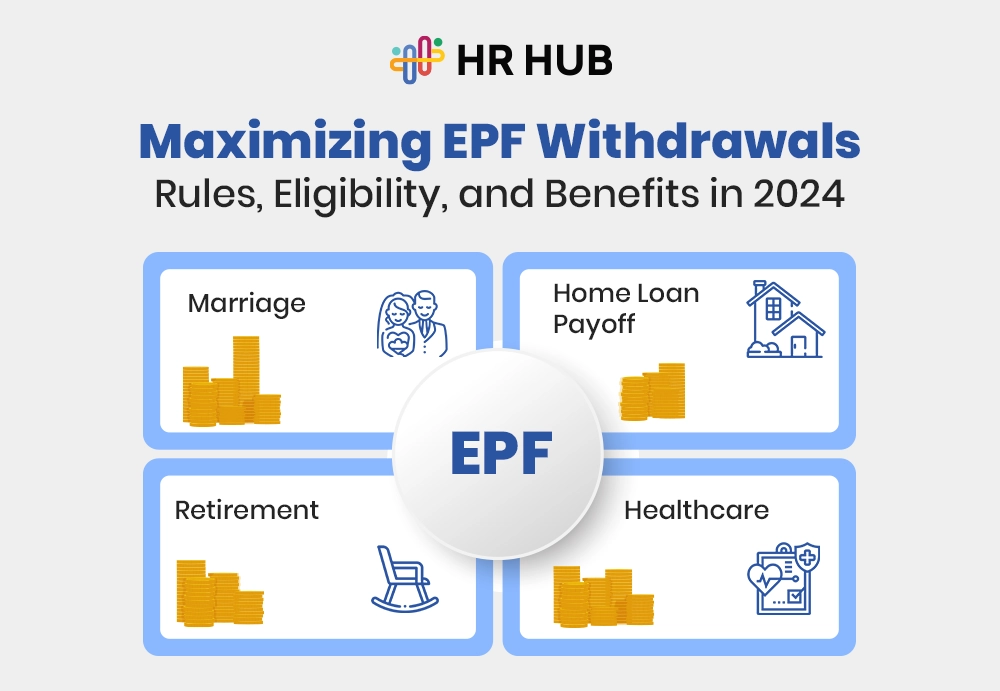A New Hire Walks In—Now What?
Picture this: your new hire walks through the door (or logs in from home), excited, nervous, and eager to start. But instead of a smooth welcome, they’re handed a stack of paperwork, asked to “wait a bit” for their laptop setup, and are unsure who their manager is or when training begins.
Sound familiar?
That’s the hidden chaos of manual onboarding—a process that feels more like a scavenger hunt than a welcome party. Small businesses often think, “We’re too small for fancy systems.” But here’s the twist: hr onboarding software isn’t about size—it’s about making every new hire count.
Let’s unravel how digital onboarding transforms this experience—and whether sticking to your manual ways is quietly holding your growth hostage.
When “Old-School” Doesn’t Cut It Anymore
Once upon a time, onboarding meant printed contracts, repeated emails, and informal greetings. In small setups, that felt personal. But as the hiring rate grows—or even as roles become more remote or regulated—manual onboarding starts behaving like a leaky pipe.
You spend hours chasing signatures. You forgot who still needs to upload documents. You onboard one person smoothly, but the next one? Total mess.
It’s not your fault—it’s just the nature of manual processes. They don’t scale. They don’t track. They don’t care if you forget something crucial.
That’s where the new-age magic of employee onboarding software for small businesses steps in.

What Exactly Is HR Onboarding Software?
Think of hr onboarding software as your behind-the-scenes assistant—one that never forgets, never misplaces a file, and always sends the welcome email on time.
It’s not just a tool. It’s a system that:
- Greet your new hire before day one
- Sends them their forms and contracts digitally
- Tracks each task without you manually checking
- Reminds your IT team to set up devices
- Follows up on compliance steps you didn’t know you missed
And all of it, on autopilot.
For small businesses juggling 10 tasks at once, this automation is not a luxury—it’s how you stay sane while scaling up.
The Hidden Costs of “Doing It Yourself”
Manual onboarding feels free—until it quietly starts costing you more than money. At first glance, using spreadsheets, emails, and paper forms seems budget-friendly. But underneath the surface, it’s bleeding time, productivity, and morale.
Let’s break it down:
Lost Productivity
Admins, HR managers, or even founders often spend hours collecting forms, chasing missing documents, and creating repetitive email templates. What should take minutes gets dragged across days. Worse, this time could’ve been spent hiring better, building culture, or improving operations.
Employee Frustration
Imagine being excited to join a company, only to wait for your email ID, ask three different people about your role, and stumble through your first week without any clear direction. Manual onboarding often leads to delays, awkward starts, and new hires who feel invisible on Day 1.
Risky Mistakes
Onboarding isn’t just about checklists—it’s about compliance too. From background checks to tax forms to digital signatures, every missed step becomes a potential legal or operational hazard.
Poor Retention
Here’s the deal: 1 in 3 employees decides to quit within the first 90 days—and onboarding plays a key role. When new hires feel lost, disengaged, or unsupported, they’re unlikely to stay long. And every early exit costs you 2x the employee’s salary in hiring and training expenses.
The worst part? Most of these issues are invisible—until the consequences show up. Low morale, HR burnout, a new hire ghosting after a week, or a disgruntled review on Glassdoor. By then, the damage is already done.
Inconsistent Processes Across Departments
Without a centralized onboarding system, each department or team member may approach onboarding differently. While one manager might send an onboarding checklist, another may rely on ad-hoc conversations or outdated templates. This creates an inconsistent experience that leaves some employees feeling unsupported or misinformed.
Over time, these inconsistencies damage internal trust and create bottlenecks—especially when cross-functional collaboration is involved.
Delayed Payroll Setup and Admin Backlogs
One of the most common issues in manual onboarding is missed or delayed salary processing due to incomplete documentation. Whether it's bank details, tax declarations, or ID verification, any small delay can lead to late salary credits—impacting employee satisfaction from day one.
Payroll teams are then forced to chase new hires or managers for documents, creating backlogs that extend into future cycles.
Knowledge Dependency on Individuals
Manual onboarding processes often live in someone’s head or scattered email threads. If that person is on leave or leaves the company, the process collapses. There’s no structured documentation, no workflow to fall back on, and no way to track what’s been done or missed.
This knowledge dependency becomes a serious liability as your team grows.
Increased Legal and Compliance Risk
Missing even one document—like a signed NDA, contract, or tax declaration—can put your company at risk. Manual processes offer no visibility or audit trail to prove compliance during inspections, audits, or legal disputes. This becomes especially risky if you're expanding into regulated industries or global hiring.
Negative Employer Branding and Lost Referrals
New employees who feel lost or unsupported during onboarding are less likely to recommend your company to others. Worse, they may share their negative experience on review platforms. A poor onboarding experience can quietly damage your reputation, making it harder to attract top talent in the future.
Manual onboarding doesn’t just slow you down—it silently chips away at your company’s foundation.
The Small Business Superpower You Didn’t Know You Needed
Now let’s flip the script.
What if onboarding weren’t a checklist but a well-oiled journey? One that runs automatically, adapts to each role, and delights every new hire. Sounds like something only big companies can do, right?
Wrong.
Today’s employee onboarding software for small businesses is the ultimate equalizer. It’s designed for small teams who want to punch above their weight—without breaking the bank.
These platforms are:
- Lightweight: No bloated features or IT dependencies
- Cloud-based: Access from anywhere, anytime—perfect for hybrid teams
- Customizable: Create workflows by role, department, or location
- Budget-smart: Pay-as-you-go plans that grow with your business
Let’s dive deeper into what that delivers:
Consistency
Every new hire gets the same high-quality experience—whether you’re hiring one intern or onboarding five new managers. No forgotten steps. No missing links. Just seamless delivery, every time.
Clarity
Onboarding software offers real-time dashboards that let you track progress, spot bottlenecks, and ensure nothing falls through the cracks. New hires know exactly what to expect, and HR knows exactly what’s been completed.
Speed
From paperwork to passwords, everything is ready before the new hire arrives. That means less hand-holding, faster setup, and quicker integration into the team.
Mobile-First Experiences for Flexibility
Modern onboarding platforms are designed with mobility in mind. Whether your new hire is a field sales executive, a remote developer, or an operations lead on the move, onboarding software allows them to upload documents, access checklists, and complete tasks from their smartphone—no laptops or in-office visits required.
This is particularly important for small businesses with distributed teams or hybrid setups.
Seamless Integration With Existing Tools
Onboarding doesn’t happen in a vacuum. Good onboarding software connects seamlessly with your payroll systems, attendance trackers, communication platforms, and task managers. This ensures a unified experience for both HR and new hires—without the need to manually update each system.
Modular and Role-Based Workflows
One-size-fits-all onboarding is inefficient and overwhelming. With modern tools, you can build onboarding tracks by department, location, or job level. Your sales hires receive pitch decks and CRM access, while your developers get repository links and dev tool access—all without manual effort.
This role-specific customization improves clarity and speeds up integration.
Data-Driven Decision Making
Many onboarding platforms now provide analytics and insights. You can track how long onboarding takes, where most delays occur, and which tasks are frequently skipped or completed late. These insights help HR teams improve onboarding efficiency and ensure that employees are engaged from day one.
For small businesses, having access to this kind of data can inform smarter decisions as you scale.
Immediate Scalability Without Hiring More HR Staff
Instead of hiring additional HR personnel to handle growing onboarding needs, you can rely on software to handle the load. Whether you're onboarding one employee per quarter or ten per month, the system scales automatically—allowing your existing HR team to focus on culture, development, and compliance.
Brand Value
You might be a 4-person startup—but when onboarding feels intuitive, professional, and personalized, it sends a strong signal: “We care.” That builds trust. That builds culture. That retains talent.
And yes, looking polished gives you a hiring edge against bigger competitors with clunky systems.
And this experience isn’t reserved for HR-heavy companies.
With platforms like HR HUB, even the leanest businesses can set up:
- Ready-to-use onboarding workflows
- Document signing and compliance tracking
- Pre-joining engagement emails and task lists
- Role-based process customization
- Mobile-first experiences for today’s remote workforce
Human resources onboarding software has gone from being a corporate luxury to a startup necessity. And the sooner you adopt it, the faster you position your team for success.

Side-by-Side: Employee Onboarding Software vs. Manual Processes
Here’s a detailed and engaging comparison table between Employee Onboarding Software and Manual Processes.

Rethinking “Welcome Aboard”
In today’s business world, onboarding isn’t a back-office process—it’s a brand moment. It’s your handshake. Your story. Your promise.
And whether you deliver that through a chaotic inbox or a polished platform—that’s your call.
But if you’re ready to leave behind the guesswork, delays, and missed steps… It might be time to say hello to onboarding that works as hard as you do.
Let HR HUB show you how.






